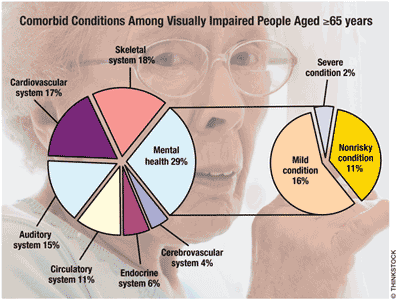US Pharm. 2010;35(4):24.
Visual impairment is among the top 10 disabilities in people older than 70 years. Blindness or low vision affected more than 3.3 million people aged 40 years and older, and the Centers for Disease Control and Prevention (CDC) predicts this number to double by 2030. The leading causes of low vision are age-related macular degeneration (AMD), cataract, diabetic retinopathy (DR), and glaucoma. AMD, which affects 1.8 million people, will affect an estimated 2.95 million by 2020, and another 7.3 million are at substantial risk for developing it. Although 61 million adults are at high risk for serious vision loss, only half have visited an eye doctor.

Types of Vision Problems: Refractive errors, the most common eye problem in a person’s 40s, can be corrected with eyeglasses, contact lenses, or surgery. Myopia is the most prevalent condition (33.1%) in this age group, whereas hyperopia is the most prevalent among people older than 60 years. The National Eye Institute found that the prevalence of myopia increased 66% between 1971–1972 and 1999–2004. Refractive correction could improve vision in 11 million Americans aged 12 years and older.
By age 80, more than half of Americans have a cataract or have had a cataract removed. Roughly 1.35 million cataract operations are performed annually, at a cost of $3.5 billion. Healthy People 2010 (HP2010) has set a goal of reducing cataract prevalence from 118.8 per 1,000 persons (in 2002) to 91.4.
People with diabetes are at risk for developing DR. While the prevalence of DR is lowest among those with type 1 diabetes, the rate increases with age for diabetic patients older than 40 years. HP2010 aims to reduce the number of adults with DR from 45.9 per 1,000 (in 2002) to 40.9. An estimated 4.1 million and 899,000 Americans, respectively, are affected by retinopathy and vision-threatening retinopathy.
Comorbid Conditions: A 2006 CDC study (Crews et al) revealed that 5.7 million people aged 65 years and older reported vision loss and were more likely than people without vision loss to experience comorbid chronic conditions. The number of older people with vision loss and comorbid conditions is sizable: 1.2 million experience vision loss and diabetes; 3 million have compromised hearing and vision; 3 million have vision loss and mild-to-moderate depression; 350,000 experience vision loss and severe depression; and nearly 900,000 have stroke and vision loss.
Consequences: Vision loss exacts a heavy toll from millions of people, including significant suffering, disability, loss of productivity, and diminished quality of life. More than 70% of CDC survey respondents indicated that loss of eyesight would have the greatest impact on their day-to-day life; however, fewer than 11% of respondents knew that there are no early warning signs for glaucoma or DR.
To comment on this article, contact rdavidson@uspharmacist.com.






